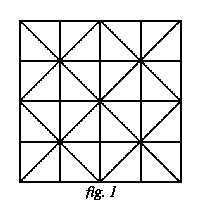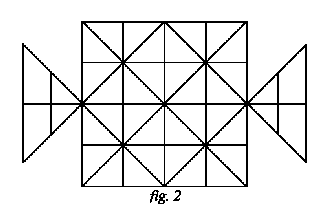
Sher-bakar

Sher-bakar


Tiger games are hunt games from Asia played on Alquerque boards (fig.1), or enlarged Alquerque boards (of which fig.2 is the most important variant). The number of tigers varies from one to four, and the number of goats from eleven or twelve to twenty-three or twenty-four. The general aim is to hem in the tigers so that they cannot move, but the general arrangement of the pieces, the method of play, and the rules of capture vary from game to game. These games are related to Asian leopard games (here).
Main tapal empat derives from Malay Peninsula, south of Thailand. It is played on board (1). The play begins with two black Tigers on the centre square and 18 white stones (‘goats’) beside the board that must be dropped in the first 18 moves. Tigers can capture stones by the short leap, but only one at a time. Capture is not mandatory. Tigers can move any distance along the lines. White can only move one square per move, after all stones have been dropped. White wins by surrounding the Tigers so that they are stalemated. Black wins by reducing the number of white stones so they can’t stalemate the black Tigers. In the typical case White would give up if he is reduced to ten stones. White makes the first move.
Bagh bandi derives from India, Lower Bengal. It is played on board (1). The play begins with two black Tigers on c3 and a3, and 20 white stones placed in piles on b2, b4, d2, d4. Tigers can capture stones by the short leap, but only one at a time. Capture is not mandatory. Both White and Black can only move one square at a time. White wins by surrounding the Tigers so that they are stalemated. Black wins by reducing the number of white stones so they can’t stalemate the black Tigers. White makes the first move.
Sher-bakar (upmost image) derives from India, Punjab. It is played on board (1). The play begins with two black Tigers on a3 and e3, and 19 white stones placed on b2, b4, d2, d4, in piles of five on three of these points and four on the remaining point. Tigers can capture stones by the short leap, but only one at a time. Capture is not mandatory. Both White and Black can only move one square at a time. White wins by surrounding the Tigers so that they are stalemated. Black wins by reducing the number of white stones so they can’t stalemate the black Tigers. White makes the first move.
Bagha Chal (Bagh Chal) means “moving tiger”. It is the national game of Nepal, and is also played in Tibet. It is played on board (1). The play begins with four black Tigers in the corners, and 20 white stones (‘goats’) beside the board that must be dropped in the first 20 moves. Tigers can capture stones by the short leap, but only one at a time. Capture is not mandatory. Both White and Black can only move one square at a time. White wins by surrounding the Tigers so that they are stalemated. Black wins by reducing the number of white stones so they can’t stalemate the black Tigers, when White usually gives up (typically, after having lost 5-7 stones). White makes the first move.
Rimau-rimau (A) derives from Malay Peninsula, south of Thailand. It is played on board (2). The play begins with two black Tigers on the vertex of the triangles, and 24 white stones (‘men’), nine of which are placed on the nine central points of the square. Tigers can capture stones by the short leap. It can capture several men at a time, provided that the number of jumps is an odd number. Capture is not mandatory. Both White and Black can only move one square at a time. White wins by surrounding the Tigers so that they are stalemated. Black wins by reducing the number of white stones so they can’t stalemate the black Tigers. The game begins by Black removing any three white men, and placing one of the black stones on any vacant point. Rimau-rimau means ‘tigers’. The white pieces are called orang, which means ‘man’ . The two triangles are called gunung, which means ‘mountain’. The board is generally cut out of black or white cloth, and the lines are worked in red. Sometimes the board is of wood, and if no board is available, the Malays will trace one on the ground.
Rimau-rimau (B). This variant is (was) played by the Peninsular Deli and Menang-kabau Malays, Malay Peninsula, south of Thailand. It is played on board (2). The play begins with two black Tigers on the vertex of the triangles (or anywhere on the board), and 22 white stones, eight of which are placed on the eight points surrounding the central square. Tigers can capture stones by the short leap, but only one at a time. Capture is not mandatory. Both White and Black can only move one square at a time. White wins by surrounding the Tigers so that they are stalemated. Black wins by reducing the number of white stones so they can’t stalemate the black Tigers. The game begins by Black removing one white man, and placing one of the black stones on any vacant point.
Strategy
The white stones should try to drive the Tigers toward the edge of the board. White must also try to take control of important positions on the diagonal matrix (which has more freedoms), the most important being the centre square. He must probably be prepared to sacrifice a stone to take control of the centre square. In the variants with enlarged board White must probably take control of the ‘mountains’ (the triangles) so that Black cannot enter these. In these implementations, White cannot choose the passive strategy of going back and forth because White always loses if a position is repeated three times.
© Mats Winther (August 2006).
See also:
Winther, M. (2006). ‘Buga-shadara - a folk game from Tuva’. (here)
------- (2005). ‘Asian Leopard games’. (here)
References
(1) Murray, H.J.R. (1952). A History of Board-games other than Chess. Oxford University Press.
(2) Spectrum Wellbeing (wooden and metallic board games). (here)
(3) Masters Traditional Games. (here)
☛ You can download my free Asian Tiger games program here (updated 2009-10-21), but you must own the software Zillions of Games to be able to run it (I recommend the download version).